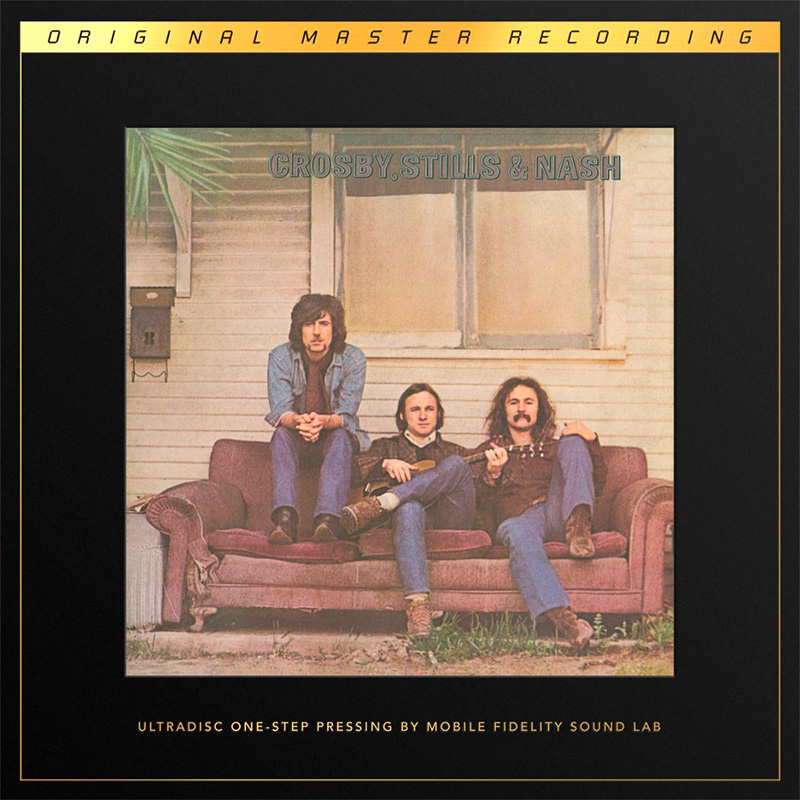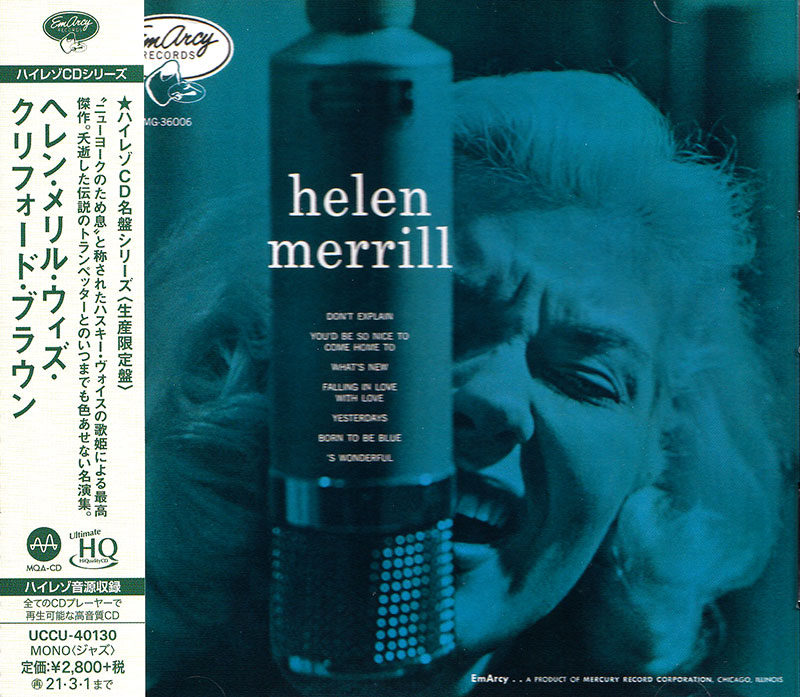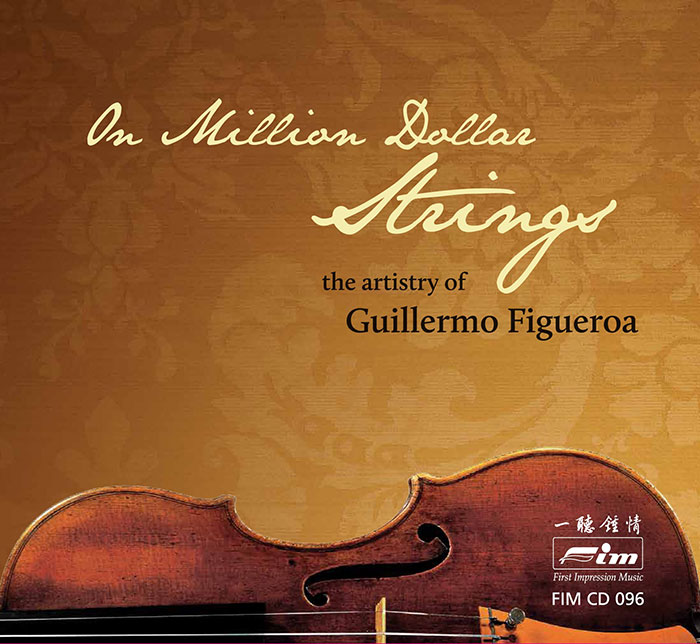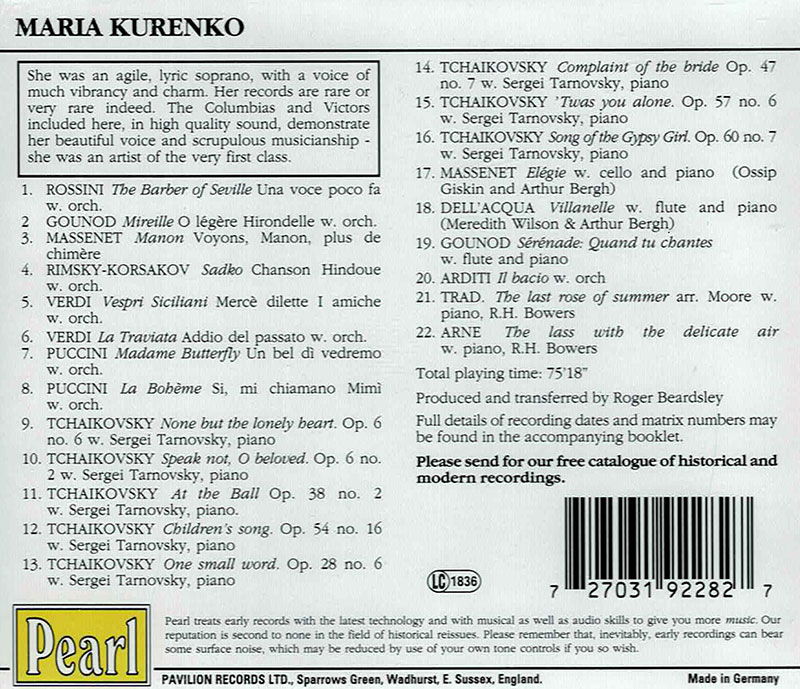Logowanie
OSTATNIE EGZEMPLARZE
Jakość LABORATORYJNA!
ORFF, Gundula Janowitz, Gerhard Stolze, Dietrich-Fischer Dieskau, Deutsche Oper Berlin, Eugen Jochum
Carmina Burana
ESOTERIC - NUMER JEDEN W ŚWIECIE AUDIOFILII I MELOMANÓW - SACD HYBR
Winylowy niezbędnik
ClearAudio
Essence MC
kumulacja zoptymalizowana: najlepsze z najważniejszych i najważniejsze z najlepszych cech przetworników Clearaudio
Direct-To-Disc
PIAZZOLLA, ChamberJam Europe
Tangos del Ángel y del Diablo
Direct-to-Disc ( D2D ) - Numbered Limited Edition
ROSSINI, GOUNOD, MASSENET, PUCCINI, TCHAIKOVSKY, Maria Kurenko
The Lass with the Delicate Air
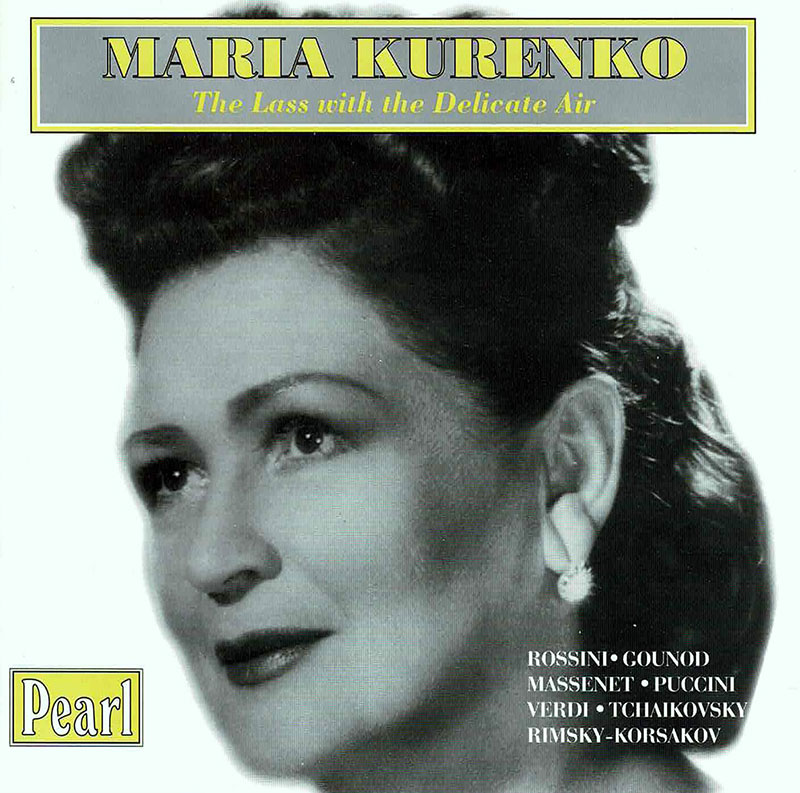
- 1. Il barbičre di Siviglia (The Barber of Seville), opera Uno voce poco fa
- Composed by Gioachino Rossini
- with Maria Kurenko
- 2. Mireille, opera O légčre Hirondelle
- Composed by Charles Gounod
- with Maria Kurenko
- 3. Manon, opera Voyons, Manon, plus de chimčre
- Composed by Jules Massenet
- with Maria Kurenko
- 4. Sadko, opera in 3 (or 5) acts Chanson Hindoue
- Composed by Nikolay Andreyevich Rimsky-Korsakov
- with Maria Kurenko
- 5. I Vespri siciliani, opera (Les vępres siciliennes) Mercč dilette I amiche
- Composed by Giuseppe Verdi
- with Maria Kurenko
- 6. La Traviata, opera Addio del passato
- Composed by Giuseppe Verdi
- with Maria Kurenko
- 7. Madama Butterfly (Madame Butterfly), opera Un bel dě vedremo
- Composed by Giacomo Puccini
- with Maria Kurenko
- 8. La bohčme, opera Si, mi chiamano Mim
- Composed by Giacomo Puccini
- with Maria Kurenko
- 9. None but the lonely heart, song for voice & piano, Op. 6/6
- Composed by Pyotr Il'yich Tchaikovsky
- with Maria Kurenko
- 10. Not a word, O my friend, song for voice & piano, Op. 6/2
- Composed by Pyotr Il'yich Tchaikovsky
- with Maria Kurenko
- 11. It was in early spring (At the ball), song for voice & piano, Op. 38/2
- Composed by Pyotr Il'yich Tchaikovsky
- with Maria Kurenko
- 12. Child's Song, song for voice & piano (Children's Songs), Op. 54/16
- Composed by Pyotr Il'yich Tchaikovsky
- with Maria Kurenko
- 13. The fearful moment, song for voice & piano, Op. 28/6
- Composed by Pyotr Il'yich Tchaikovsky
- with Maria Kurenko
- 14. Was I not a little blade of grass?, song for voice & piano (also arr. for cello & strings), Op. 47/7
- Composed by Pyotr Il'yich Tchaikovsky
- with Maria Kurenko
- 15. Twas you alone, song for voice & piano, Op. 57/6
- Composed by Pyotr Il'yich Tchaikovsky
- with Maria Kurenko
- 16. Work(s) Song of the Gypsy Girl
- Composed by Pyotr Il'yich Tchaikovsky
- with Maria Kurenko
- 17. Élégie "O doux printemps d'autrefois," for voice & piano
- Composed by Jules Massenet
- with Arthur Bergh, Maria Kurenko
- 18. La Villanelle for voice & piano (or orchestra)
- Composed by Eva Dell'Acqua
- with Meredith Willson, Arthur Bergh, Maria Kurenko
- 19. Sérénade
- Composed by Charles Gounod
- with Meredith Willson, Arthur Bergh, Maria Kurenko
- 20. Il Bacio, for voice & piano (or orchestra)
- Composed by Luigi Arditi
- with Maria Kurenko
- 21. The Last Rose of Summer
- Composed by Anonymous
- with Maria Kurenko
- 22. Lass with the delicate air
- Composed by Thomas Augustine Arne
- with Maria Kurenko
- Maria Kurenko - soprano
- ROSSINI
- GOUNOD
- MASSENET
- PUCCINI
- TCHAIKOVSKY
MARIA KURENKO Maria Mikhailovna Kurenko (Kurenkova, Kurenko-Gontsova) was born on 2 January (or 14 January by the Gregorian calendar), 1890 in Tomak, Tomsky Province (Siberia). Her early life is somewhat obscure, but it is known that she was born into a merchant family, the youngest of four daughters. The family moved to Moscow when she was very young. Her musical education began there at the age of twelve, when she entered the Moscow Conservatory. She later became a pupil there of the Italian vocal coach Umberto Masetti. Among his pupils were numbered other great singers: Nina Koshetz, Antonina Nezhdanova and Nadezhda Obukhova. She also studied law for three years at the University of Moscow and graduated from both institutions at more or less the same time in 1913 or 1914. Kurenko made her operatic debut in 1914 at the Kharkov Opera in the role of Antonida in Glinka's A Life for the Tsar. From 1918-1922 she was a soloist at the Bolshoi Theatre, Moscow and from 19221923 at the Kiev Opera. She emigrated from the USSR in 1923 and spent the next year singing in concert in Paris, Germany, Finland, Iceland and other European cities, though exact details have not been traced. In Autumn 1925 she moved to the USA, which she made her home. Her operatic debut was on or around 30 September 1925, as Gilda in Rigoletto with the Los Angeles Opera Company. Her fellow artists were the American tenor Charles Hackett as the Duke and the Spanish baritone Vincente Ballester as Rigoletto. Of her debut the critic of Musical America wrote, `Maria Kurenko, Russian Coloratura soprano, in her American debut disclosed charm of voice and magnetic personality as Gilda'. Even more successful was her next appearance, as Lakme, on 3 October again with Hackett and with Edouard Cotreuil as Nilakanthe. Carl Bronson in the Los Angeles Herald thought that `Kurenko proved herself one of the most brilliant sopranos of the day, possessing a voice of unblemished purity'. Kurenko's name rapidly spread throughout the US via the medium of radio. From about December 1925 she began broadcasting, sponsored by the Atwater Kent company. Her next important debut was with the Philadelphia Civic Opera Company on 11 February 1926 when she again sang Gilda, with the local tenor Norbert Adler, the Russian baritone Ivan Ivantsov and Henri Scorr as Sparafucile. H.T. Craven in Musical America found her `... a charming and convincing Gilda. Her voice is of purity and easy resourcefulness, qualities which served her admirably in the `Caro nome' and other stellar numbers. ......A capacity house greeted the performance with marked enthusiasm, reserving a wealth of plaudits for Mme. Kurenko.' In between these opera appearances she was establishing herself as a favourite recitalist. While on the West coast she had performed in concert in San Francisco, Portland and Seattle and, travelling East, made her debut in Boston in concert on 7 January 1926. Her New York debut took place on 16 January at Carnegie Hall. It is worth quoting at length from the review in Musical America, for not only does the critic give a particularly objective review of her singing on this occasion but her repertoire is listed: Maria Kurenko, a Russian coloratura soprano who has sung with success in other parts of the country, made her New York debut in Carnegie Hall on the afternoon of Jan 16, with Myron Jacobson at the piano and John Amadio contributing occasional flute obbligatos. Interest in her singing increased as the afternoon wore on. She was best in intimate songs of a light and cheerful character. The voice, throughout the recital, was more effective in its medium and low range, the latter being of extraordinary beauty and good placement for a singer who has wandered in the pleasant fields of fioritura. The quality is fresh and save for an occasional stringency almost like putting a lid on the upper tones, the placement was even and effortless. Had she been announced as a lyric soprano, one might have dwelt upon the very beautiful lyric singing which Mme. Kurenko did, and let some far less interesting coloratura go by the boards as an avocation. As she challenged a verdict as a coloratura, one must admit that none of the fioritura was in any way striking. She exhibited a tendency to aspirate her scales and turns instead of singing them with a straight `ah', and in very high passages the tone was constricted and the notation not invariably clear. In the gruelling aria of Constanze from Mozart's Die Entfurubg a couple of measures towards the end were omitted entirely. The Dinorah `Shadow Song', however, was delicately done and much nearer the technical perfection this sort of music requires if it is to be sung at all. Mme. Kurenko's voice seems to be a lyric one, pure and simple, and her coloratura tendencies, one would say, were psychic rather than physical. The programme opened with a group by Handel, Giordigiani and Mozart. This was followed by excerpts from Snegourotchka, Glinka's A Life for the Tsar and Dinorab. The fourth brace was of songs by Sibelius, Reger, and Leoncavallo, and the scene from Act 1 of Massenet's Manon. The final group was a somewhat altered version of Gounod's `Berceuse-Serenade' with flute obbligato, and a part of the Mad Scene from Lucia. With her second group, Mme. Kurenko began to do some lovely singing. The Snegourotcbka aria was nicely sung, so also Tchaikovsky's inconsequential `A Song'. The vivacious Hornpipe from A Life for the Tsarwas wholly delightful in spirit and was sung with fine tone. As encore for the Dinorah she sang Chopin's `The Maiden's Wish' a song put off the recital map once and for all by a singer named Marcella Sembrich. As a second encore Mme. Kurenko sang deliciously Pere Martini's Minuet'Mes Moutons je Mene en ce Sejour', which evoked memories of the late Lillian Henschel. The fourth group was not striking save for the Manor scene. This was a really fine piece of singing, not only from the vocal point but also histrionically. One may conjecture that Mme. Kurenko would make an alluring Manon in every respect.' The above critic's review is, from our perspective, very perceptive, for Kurenko gradually began to lean more towards the lyric repertoire and less to that of the leggiero. However, there still remained one important opera debut: at the Chicago Civic Opera on 25 January 1927, as Rosina in It Barbiere di Siviglia with Hackett, Richard Bonelli and Virgilio Lazzari with Moranzoni conducting. She appears to have sung only one performance, when she took over from Toti Dal Monte. Though she was received well enough by the audience, she appears to have divided the critics. Maurice Rosenfeld in the Chicago Daily News wrote that `she gained a very creditable success with her representation of the dramatic and lyric demands of this part. She has an airy grace and light style and she is letter perfect in her music ' However, Edward Moore of the Chicago Tribune was still smarting from the demise of Amelita Galli-Curci at that house. He felt that `she sang the part correctly enough to be fairly satisfactory in a high, rather small, and somewhat wiry voice... Otherwise one hardly believes that she will erase the memories of Galli-Curci...... For the next twenty years Kurenko gave endless recitals and appeared with most of the major orchestras under such conductors as Reiner, Toscanini, Gabrilowitsch, Koussevitsky and Molinari. She was also a regular radio broadcaster: as well as the Atwater Kent programmes mentioned earlier, she performed in wellknown radio hours sponsored by General Motors and Vitaphone. She was especially famous as an interpreter of Gretchaninov. The composer himself had left Russia in 1925 and now spent most of his time in Paris and the USA, where he made his home in Detroit. She was his preferred interpreter of his songs and they gave several all-Gretchaninov song-concerts together, such as the one in Detroit on 10 December 1939. He dedicated his song `Declaration of Love' to her. Kurenko later recorded it for Victor, one in an album of his songs. Two highlights in the Kurenko career are worthy of special mention. The first was her creation of the role of Parasha in the US premiere of Stravinsky's Mavra on 28 December 1934. This was staged at the Academy of Music in Philadelphia as part of a double bill, with Hansel and Gretel. Also of note was her appearance in a concert performance of A Life for the Tsar at the Lewisohn Stadium, New York in 1936, as Antonida, the role of her debut some twentytwo years earlier. Though she continued to appear into the `50s, Kurenko became a member of the Juilliard Summer School from 1948 until 1952. There she taught song interpretation and performance. Maria Kurenko died on 17 May 1980 in New York. JOHN WILLIAMS Producer's note Maria Kurenko's recording career was among the longest of any singer's. Her first records were made around 1913 in Kiev for the Artistotipia label; the last, LPs in USA around 1954. The voice was an agile, lyric soprano of great clarity and projection, with just a touch of tannin in the tone which, like a fine wine, gives it interest and individuality. Yet she is relatively neglected among collectors and this is the first reissue of her best recordings for many years. Her name is not well known in the UK, because regrettably Columbia did not see fit to issue her records in Great Britain. It is hard to understand why in view of the vibrancy and charm of these early electńcs made in the US. Her records even in America are not all that common, indeed one on this CD, the Gounod Serenade/ Villanelle has only been seen by one of the leading American dealers, Jim Peters, in an Australian pressing (and then only once) which through his generosity is reproduced here. The minor, but ineradicable results of wear on this rare disc, are felt to be insignificant enough not to prevent inclusion. All the records on this CD were made for Columbia and Victor. Although the Columbias are technically superb for their period, for some reason they play below 78: many of them as slow as 74 rpm. If played at 78 the voice is reproduced with a high, somewhat shrill, imingratiating tone which may account for her neglect. On this CD great care has been taken to transfer the discs at the correct pitch. At the right speed many of these are performances to treasure, demonstrating an artist whose beautiful voice commands a wide range of vocal colours, interpretative ability and scrupulous musicianship. In short, an artist of the first class, and one whose A major article about, and discography of, Kurenko was published in The Record Collector Volume 42, Number 3 (September 1997).

